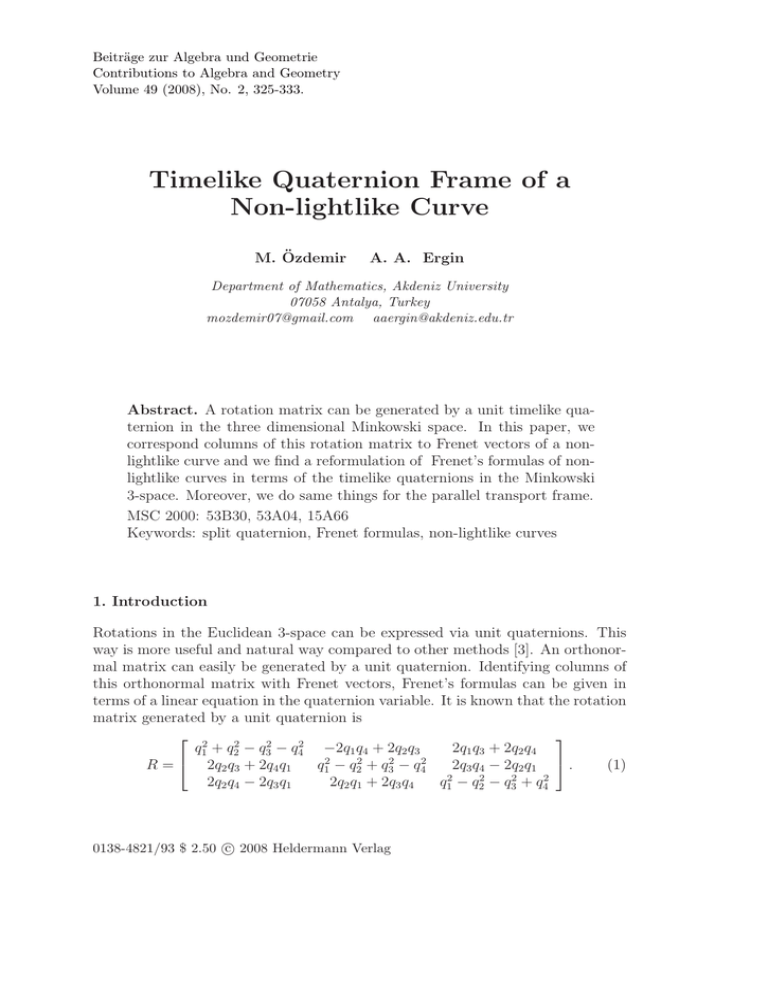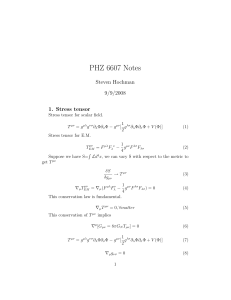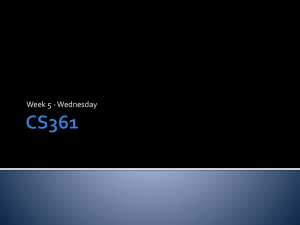Beitr¨ age zur Algebra und Geometrie Contributions to Algebra and Geometry
advertisement

Beiträge zur Algebra und Geometrie
Contributions to Algebra and Geometry
Volume 49 (2008), No. 2, 325-333.
Timelike Quaternion Frame of a
Non-lightlike Curve
M. Özdemir
A. A. Ergin
Department of Mathematics, Akdeniz University
07058 Antalya, Turkey
mozdemir07@gmail.com aaergin@akdeniz.edu.tr
Abstract. A rotation matrix can be generated by a unit timelike quaternion in the three dimensional Minkowski space. In this paper, we
correspond columns of this rotation matrix to Frenet vectors of a nonlightlike curve and we find a reformulation of Frenet’s formulas of nonlightlike curves in terms of the timelike quaternions in the Minkowski
3-space. Moreover, we do same things for the parallel transport frame.
MSC 2000: 53B30, 53A04, 15A66
Keywords: split quaternion, Frenet formulas, non-lightlike curves
1. Introduction
Rotations in the Euclidean 3-space can be expressed via unit quaternions. This
way is more useful and natural way compared to other methods [3]. An orthonormal matrix can easily be generated by a unit quaternion. Identifying columns of
this orthonormal matrix with Frenet vectors, Frenet’s formulas can be given in
terms of a linear equation in the quaternion variable. It is known that the rotation
matrix generated by a unit quaternion is
2
q1 + q22 − q32 − q42 −2q1 q4 + 2q2 q3
2q1 q3 + 2q2 q4
q12 − q22 + q32 − q42
2q3 q4 − 2q2 q1 .
(1)
R = 2q2 q3 + 2q4 q1
2
2
2
2
2q2 q4 − 2q3 q1
2q2 q1 + 2q3 q4
q1 − q2 − q 3 + q4
c 2008 Heldermann Verlag
0138-4821/93 $ 2.50 326
M. Özdemir, A. A. Ergin: Timelike Quaternion Frame of . . .
~ (s) , B
~ (s)
If the columns of this matrix are identified with Frenet vectors T~ (s) , N
respectively, the quaternion Frenet formulas can be expressed as
0
q1 (s)
0
−τ (s)
0
−κ (s)
q1 (s)
q2 (s)
q20 (s) τ (s)
0
−κ (s)
0
0
(2)
q3 (s) = 0
−κ (s)
0
τ (s) q3 (s)
q4 (s)
κ (s)
0
−τ (s)
0
q40 (s)
where κ (s) and τ (s) are curvature and torsion functions of the curve. Similarly, if the columns of the matrix are identified with the parallel transport frame
~ 1 (s) , T~ (s) , N
~ 2 (s)}, the parallel transport frame equations can be expressed as
{N
0
q1 (s)
q1 (s)
0
−k2 (s)
0
k1 (s)
q20 (s) k2 (s)
0
−k1 (s)
0
0
q2 (s)
(3)
q3 (s) =
q3 (s)
0
k1 (s)
0
k2 (s)
q4 (s)
−k1 (s)
0
−k2 (s)
0
q40 (s)
~ 1 and N
~ 2 respectively ([2],
where k1 , k2 are principal curvatures with respect to N
[3]). Parallel transport frame and the comparing parallel transport frame with
Frenet frame in the Euclidean 3-space were given by Bishop [1] and Hanson [2]
in detail. The quaternion derivative formulas (2) and (3) allow us to do the same
things we did the Frenet formulas and the parallel transport frame equations.
Split quaternion algebra is an associative, non-commutative non-division ring
with four basic elements {1, i, j, k} satisfying the equalities i2 = −1, j 2 = k 2 =
ijk = 1. Split quaternions were also known as coquaternions and were put forward
by James Cockle in 1849. For the detailed information about split quaternions,
we refer to the references [5], [4], [7] and [8]. The split quaternion product of two
split quaternions p = (p1 , p2 , p3 , p4 ) and q = (q1 , q2 , q3 , q4 ) is defined by
p ∗ q = p1 q1 + < V~ p, V~ q >L +p1 V~ q + q1 V~ p + V~ p ∧L V~ q
where h, iL and ∧L are Lorentzian inner product and vector product respectively.
Scalar and vector parts of split quaternion q are denoted by Sq = q1 and V~ q =
q2 i + q3 j + q4 k respectively. Let q = (q1 , q2 , q3 , q4 ) = Sq + V~ q be a split quaternion.
The conjugate of a split quaternion, denoted Kq, is defined as Kq = Sq − V~ q.
The conjugate of the sum of quaternions is the sum of their conjugates.
A split quaternion q is called spacelike, timelike or lightlike, if Iq < 0, Iq > 0
or Iq = 0 respectively where Iq = q ∗ Kq = Kqp∗ q = q12 + q22 − q32 − q42 . The
norm of the q = (q1 , q2 , q3 , q4 ) is defined as N q = |q12 + q22 − q32 − q42 |. If N q = 1
then q is called unit split quaternion and q0 = q/N q is a unit split quaternion for
b = {q = (q1 , q2 , q3 , q4 ) :
N q 6= 0. The set of timelike quaternions denoted by TH
q1 , q2 , q3 , q4 ∈ R, Iq > 0} forms a group under the split quaternion product. Also,
b 1.
the set of unit timelike quaternions is represented by TH
A similar relation to the relationship between quaternions and rotations in
Euclidean space exists between split quaternions and Minkowski 3-space. Every 3
dimensional rotation in the Minkowski 3-space can be expressed via split quaternions. In this paper, we reformulate Frenet formulas and parallel transport frame
M. Özdemir, A. A. Ergin: Timelike Quaternion Frame of . . .
327
equations in terms of timelike quaternions. First, we give basic notions in the
Minkowski 3-space and split quaternions.
2. Preliminaries
The Minkowski space E31 is the Euclidean space E3 provided with the Lorentzian
inner product h~u, ~v iL = −u1 v1 +u2 v2 +u1 v2 where ~u = (u1 , u1 , u3 ), ~v = (v1 , v2 , v3 ) ∈
E3 . We say that a vector ~u in E31 is spacelike, lightlike or timelike if h~u, ~uiL > 0,
h~u, ~uiL = 0por h~u, ~uiL < 0 respectively. The norm of the vector ~u ∈ E31 is defined
by k~uk = |h~u, ~uiL |. Associated to that inner product, for any ~u = (u1 , u1 , u3 ),
~v = (v1 , v2 , v3 ) ∈ E31 , the Lorentzian vector product ~u ∧L ~v of ~u and ~v is defined
as follows:
~u ∧L ~v = (−u2 v3 + u3 v2 , u3 v1 − u1 v3 , u1 v2 − u2 v1 ) .
An arbitrary curve α = α (s) : I → E13 is spacelike, timelike or null, if all of
its velocity vectors α0 (s) are respectively spacelike, timelike or null, for each s ∈
~ (s) , B
~ (s) are Frenet
I ⊂ R. Let α (s) be a unit non-lightlike curve and T~ (s) , N
vectors, then Frenet formulas are as follows
~
~0
T (s)
T (s)
0
κ (s)
0
N
~ 0 (s) = (B~ ) κ (s)
~ (s)
0
τ (s) N
0
~ (s)
~ (s)
0
(T~ ) τ (s)
0
B
B
(4)
~ X
~ >L and κ (s), τ (s) are curvature and torsion functions of the
where X~ =< X,
curve respectively [10].
Parallel transport frame can be expressed as the following: for a unit non~ 1 (s) and N
~ 2 (s)
lightlike curve α (s), we take tangent vector of α (s) and choose N
unit vectors in the plane which is perpendicular to T~ such that derivatives of
~ 1 (s) and N
~ 2 (s) depend only T~ (s) not each other. This frame is independent
N
~ 10 = aT~ , N
~ 20 = bT~ and T~ 0 = cN
~ 1 + dN
~ 2,
from the curvature of the curve. Using, N
we can obtain
the parallel transport
frame equations.
n
o
~ 1 (s) , N
~ 2 (s) be parallel transport frame, then the evolution
Let T~ (s) , N
equations of this frame for a timelike curve are as follows;
~0
~
T (s)
T (s)
0
k1 (s) −k2 (s)
N
N
~ 0 (s) = k1 (s)
~ 1 (s)
0
0
1
~ 0 (s)
~ 2 (s)
−k2 (s)
0
0
N
N
2
(5)
p
and τ (s) = θ0 (s). Also,
such that κ (s) = k12 (s) + k22 (s), θ (s) = arctan kk21 (s)
(s)
the parallel transport frame equations for a spacelike curve are as follows
~0
~
T (s)
T (s)
0
k1 (s) k2 (s)
N
~ 10 (s) = −(N~ )k1 (s)
~ 1 (s)
0
0 N
1
~ 0 (s)
~ 2 (s)
−(N~ 2 )k2 (s)
0
0
N
N
2
(6)
328
M. Özdemir, A. A. Ergin: Timelike Quaternion Frame of . . .
~ X
~ >L , κ (s) =
such that X~ =< X,
q
(N~ 1 )k12 + (N~ 1 )k22 , θ (s) = arctan h kk21 (s)
(s)
0
0
~
~
~
and τ (s) = N~ 1 θ (s) [9]. Note that we can use T = k1 N1 + T~ k2 N2 for any non~ 1 (s) and N
~ (s) are same as those of
lightlike curve and the causal characters of N
~ 2 (s) and B
~ (s).
N
3. Timelike quaternion frame for a non-lightlike curve
In this section, we find a reformulation of the Frenet formulas and the parallel
transport frame equations of a non-lightlike curve in terms of a linear equation
in the quaternion variables. We do not deal with lightlike curves and the nonlightlike curves whose normal or binormal is null, since each column vector of the
matrix (7) is spacelike or timelike.
Every rotation in the Minkowski 3-space can be expressed via unit timelike quaternions. If q = (q1 , q2 , q3 , q4 ) is a timelike quaternion, using the transformation law
(q ∗ V~ r ∗ q −1 )i =
3
X
Rij (V~ r)j
j=1
the corresponding rotation matrix can be found as
2
2q1 q4 − 2q2 q3
−2q1 q3 − 2q2 q4
q1 + q22 + q32 + q42
q12 − q22 − q32 + q42 −2q3 q4 − 2q2 q1
Rq = 2q2 q3 + 2q4 q1
2q2 q4 − 2q3 q1
2q2 q1 − 2q3 q4
q12 − q22 + q32 − q42
(7)
where r = (Sr, V~ r). All rows of this matrix are orthogonal in the Lorentzian
b 1 , we obtain an
mean. In addition, if we take a unit timelike quaternion q ∈ TH
orthogonal rotation matrix in the Minkowski 3-space. Each rotation is represented
by a rotation matrix with respect to the standard basis in E31 . These matrices
form the 3-dimensional special orthogonal group SO (1, 2). Moreover, the function
b 1 →SO (1, 2) which maps q = (q1 , q2 , q3 , q4 ) to the matrix R given in
ϕ : S23 ' TH
(7) is an homomorphism of group. The kernel of ϕ is {±1} so that rotation matrix
corresponds to pair ±q of unit quaternion. In particular, SO (1, 2) is isomorphic
b 1 {±1} from the first isomorphism theorem. In other
to the quotient group TH
words, for every rotation in the Minkowski 3-space E31 , there are two unit timelike
quaternions that determine this rotation. These timelike quaternions are q and
−q [8].
The quadratic form (7) for a general orthonormal SO(1, 2) frame suggests that the
Frenet and parallel transport frame and their Frenet formulas might be expressible
directly in terms of a linear equation in the quaternion variables. To generate a
unique moving frame with its space curve for nonvanishing curvature, we can
integrate the Frenet formulas. Similarly, we may integrate the much simpler
quaternion equations.
329
M. Özdemir, A. A. Ergin: Timelike Quaternion Frame of . . .
The matrix (7) expresses all 3 dimensional rotations in the Minkowski 3-space.
Since this matrix is an orthonormal matrix in the Minkowski 3-space, we can use
it in identifying the orthonormal frame of a non-lightlike curve in the Minkowski
3-space. Therefore, we identify the columns of (7) with the elements of orthonormal frame. But, we must consider the case that the first column of (7) is timelike.
Because of that, while we identify first column with T~ (s) for a timelike curve
~ (s) for a spacelike curve with timeα (s), we should identify first column with N
like normal. While we identify the columns with elements of the Frenet frame,
~ (s) and B
~ (s) is important. That is, for a spacelike curve with
order of T~ (s) , N
~ (s) , B
~ (s) , T~ (s) (not
timelike binormal, we identify the columns in the order N
~ (s) , T~ (s) , B
~ (s)). Similarly, we consider the same things for the parallel transN
~ 1 (s) , N
~ 2 (s)}.
port frame {T~ (s) , N
3.1. Timelike quaternion frame for a timelike curve
Theorem 1. Let q = (q1 , q2 , q3 , q4 ) be a unit timelike quaternion and let (7) be
the corresponding rotation matrix. Then, the Frenet formulas (4) and the parallel
transport frame equations (5) of a unit timelike curve can be expressed in terms
of the q with
0
κ
0
− τ2 (s)
0
(s)
q1 (s)
q
(s)
1
2
q20 (s) τ (s)
0
− κ2 (s)
0
= 2
0
q2 (s)
(8)
κ
τ
q3 (s) 0
− 2 (s)
q3 (s)
0
(s)
2
κ
q40 (s)
(s)
0
− τ2 (s)
0
q4 (s)
2
and
q10 (s)
q20 (s)
0
q3 (s) =
q40 (s)
k2
0
0
(s)
2
k1
0
0
− 2 (s)
k2
k1
(s) − 2 (s)
0
2
k1
k2
(s)
(s)
0
2
2
k1
2
k2
2
(s)
q1 (s)
(s) q2 (s)
0 q3 (s)
q4 (s)
0
(9)
respectively.
~ (s) , B
~ (s) respectively.
Proof. Let us identify the columns of (7) with T~ (s) , N
2
q1 + q22 + q32 + q42
2q1 q4 − 2q2 q3
−2q1 q3 − 2q2 q4
~ = q12 − q22 − q32 +q42 , B
~ = −2q3 q4 − 2q2 q1 .
T~ = 2q2 q3 + 2q4 q1 , N
2q2 q4 − 2q3 q1
2q2 q1 − 2q3 q4
q12 − q22 + q32 − q42
It is easy to see that differentiation yields
T~ 0 (s) = 2[A][q 0 (s)],
~ 0 (s) = 2[B][q 0 (s)],
N
~ 0 (s) = 2[C][q 0 (s)],
B
q1 q2 q3 q4
q4 −q3 −q2 q1
where A = q4 q3 q2 q1 , B = q1 −q2 −q3 q4 and
−q3 q4 −q1 q2
q2 q1 −q4 −q3
330
M. Özdemir, A. A. Ergin: Timelike Quaternion Frame of . . .
−q3
C = −q2
q1
Now, using
−q4 −q1 −q2
−q1 −q4 −q3 .
−q2 q3 −q4
the fact that Frenet’s formulas (4) for a timelike curve α (s) are
~,
T~ 0 = κN
~ 0 = κT~ + τ B
~ and B
~ 0 = −τ N
~,
N
we find (8) by direct (but tedious) computations.
~ 1 (s), N
~ 2 (s)
Similarly, identifying the parallel transport frame vectors T~ (s), N
(in that order) with the columns of (7) and using the parallel transport frame
equations of a timelike curve, we get (9).
Remark 2. In the equations (8) and (9), the matrices in the right side are semi
antisymmetric for the semi-Euclidean space E42 . Recall that a matrix A is semi
antisymmetric in the semi-Euclidean space
E42 , providedthat I ∗ AI ∗ = −AT where
−1 0 0 0
0 −1 0 0
.
AT is the transpose of the A and I ∗ =
0
0 1 0
0
0 0 1
3.2. Timelike quaternion frame for a spacelike curve
In this case, we examine the timelike quaternion frame of a spacelike curve according to the normal of the curve is timelike or spacelike.
~ (s) of the spacelike curve is timelike, identifying the columns
i) If the normal N
~ (s) , B
~ (s) , T~ (s) (in that order) respectively, we find
of (7) with N
~ 0 (s) = 2[A][q 0 (s)],
N
~ 0 (s) = 2[B][q 0 (s)],
B
T~ 0 (s) = 2[C][q 0 (s)].
So, using the fact that the Frenet formulas (4) for a unit spacelike curve with
timelike normal are
~, N
~ 0 = κT~ + τ B
~ and B
~ 0 = τN
~,
T~ 0 = κN
we obtain
q 0 (s) = B1 (κ (s) , τ (s)) q (s)
where
0
0
− κ2 (s) τ2 (s)
0
0
− τ2 (s) − κ2 (s)
.
B1 (κ (s) , τ (s)) =
− κ (s) − τ (s)
0
0
2
2
κ
τ
(s) − 2 (s)
0
0
2
(10)
M. Özdemir, A. A. Ergin: Timelike Quaternion Frame of . . .
331
~ 1 , we correspond the columns of
In the parallel transport frame with timelike N
~
~
~
the matrix (7) to N1 (s) , N2 (s) and T (s) respectively. Thus, using the equations
~ 0 (s) = 2[A][q 0 (s)], N
~ 0 (s) = 2[B][q 0 (s)], T~ 0 (s) = 2[C][q 0 (s)] and the parallel
N
1
2
~ 1 + k2 N
~ 2, N
~ 10 = k1 T~ and N
~ 20 = −k2 T~ , we
transport frame equations T~ 0 = k1 N
obtain
q 0 (s) = B2 (k1 (s) , k2 (s)) q (s)
(11)
where
(s) − k21 (s)
0
− k2 (s)
0
0
− k21 (s)
2
.
B2 (k1 (s) , k2 (s)) =
k
− 1 (s)
0
0
− k22 (s)
2
0
− k21 (s) k22 (s)
0
0
k2
2
~ (s) of the spacelike curve is spacelike, we identify the columns
ii) If the normal N
~ (s) , T~ (s) , N
~ (s) (in that order) respectively and we find
of (7) with B
~ 0 (s) = 2[A][q 0 (s)], T~ 0 (s) = 2[B][q 0 (s)], N
~ 0 (s) = 2[C][q 0 (s)].
B
So, since the Frenet formulas (4) for a spacelike curve with timelike binormal are
~, N
~ 0 = −κT~ + τ B
~ and B
~ 0 = τN
~,
T~ 0 = κN
we find
q 0 (s) = B3 (κ (s) , τ (s)) q (s)
(12)
where
0
− κ2 (s) − τ2 (s)
0
κ (s)
0
0
− τ2 (s)
2
.
B3 (κ (s) , τ (s)) =
κ
− τ (s)
0
0
(s)
2
2
τ
κ
0
− 2 (s) − 2 (s)
0
~ 2 , we correspond the
At last, in the parallel transport frame with timelike N
~
~
~
columns of the matrix (7) to N1 (s) , T (s) and N2 (s) respectively. Thus, using
~ 20 (s) = 2 [A] [q 0 (s)] , T~ 0 (s) = 2 [B] [q 0 (s)] , N
~ 10 (s) = 2 [C] [q 0 (s)]
the equations N
~ 1 + k2 N
~ 2, N
~ 0 = −k1 T~ and
and the parallel transport frame equations T~ 0 = k1 N
1
0
~
~
N2 = k2 T , we obtain
q 0 (s) = B4 (k1 (s) , k2 (s)) q (s)
(13)
where
0
− k21 (s)
0
k
k2
1 (s)
0
− 2 (s)
2
B4 (k1 (s) , k2 (s)) =
0
− k22 (s)
0
k1
k2
(s)
0
− 2 (s)
2
k2
2
(s)
0
.
k1
(s)
2
0
Remark 3. The matrices B1 , B2 , B3 and B4 are semi antisymmetric for the semiEuclidean space E42 .
332
M. Özdemir, A. A. Ergin: Timelike Quaternion Frame of . . .
Now, we can express following theorems for unit spacelike curves in the 3-dimensional Minkowski space.
Theorem 4. Let q = (q1 , q2 , q3 , q4 ) be a unit timelike quaternion and let (7) be
corresponding rotation matrix. Then, the Frenet formulas (4) of a unit spacelike
curve can be expressed in terms of the q as follows:
i) q 0 (s) = B1 q (s), if normal of the curve is timelike,
ii) q 0 (s) = B3 q (s), if normal of the curve is spacelike.
Also, the parallel transport frame equations (6) of a unit spacelike curve can be
expressed in terms of the q as follows:
i) q 0 (s) = B2 q (s), if N1 is timelike,
ii) q 0 (s) = B4 q (s), if N1 is spacelike
where B1 , B2 , B3 and B4 are as above.
Thus, the Frenet formulas and the parallel transport frame equations are reformulated in terms of the timelike quaternion q = (q1 , q2 , q3 , q4 ). The matrices
B1 , B2 , B3 and B4 are semi antisymmetric matrices in the semi-Euclidean space E42
and the equality < q (s) , q 0 (s) >L = 0 holds according to the construction. These
properties guarantee that the unit timelike quaternions remain constrained to the
unit semi-Euclidean sphere S23 .
For the given continuous functions κ (s) and τ (s) , it is known that there exists
a parametric curve such that s is its arclength parameter and the given functions
κ (s) and τ (s) represent the curvature and the torsion of the curve respectively.
So, we can give the following corollary.
Corollary 5. If κ (s) and τ (s) are given, the equations (8) , (9) , (10) , (11) , (12)
~ (s) ,
and (13) can be integrated directly to find q (s) . So, the Frenet frame {T~ (s) , N
~ (s)} or the parallel transport frame {T~ (s) , N
~ 1 (s) , N
~ 2 (s)} can be generated by
B
using the matrix (7) .
References
[1] Bishop, R. L.: There is more than one way to frame a curve. Am. Math.
Zbl
0298.53001
Mon. 82(3) (1975), 246–251.
−−−−
−−−−−−−−
[2] Hanson, A. J.; Ma, H.: Quaternion frame approach to streamline visualization. IEEE Trans. Visual. Comput. Graphics 1(2) (1995), 164–174.
[3] Hanson, A. J.: Visualizing Quaternions. Morgan-Kaufmann/Elsevier, London 2006.
[4] Inoguchi, J.: Timelike surfaces of constant mean curvature in Minkowski
3-space. Tokyo J. Math. 21(1) (1998), 141–152.
Zbl
0930.53042
−−−−
−−−−−−−−
[5] Inoguchi, J.; Toda, M.: Timelike minimal surfaces via loop groups. Acta
Appl. Math. 83(3) (2004), 313–355.
Zbl pre02128493
−−−−−−−−−−−−−
[6] Kantor, I. L.; Solodovnikov, A. S.: Hypercomplex Numbers. An Elementary
Introduction to Algebras. Springer-Verlag, New York 1989. Zbl
0669.17001
−−−−
−−−−−−−−
M. Özdemir, A. A. Ergin: Timelike Quaternion Frame of . . .
333
[7] Kula, L.: Split quaternions and geometrical applications. Ankara University,
Ph.D. Thesis, 2003.
[8] Özdemir, M.; Ergin, A. A.: Rotations with unit timelike quaternions in
Minkowski 3-space. J. Geom. Phys., 56 (2006), 322–336.
Zbl
1088.53010
−−−−
−−−−−−−−
[9] Özdemir, M.; Ergin, A. A.: Parallel transport frame of non-lightlike curves.
Missouri J. Math. Sci., Preprint.
[10] Pei, D.; Sano, T.: The focal developable and the binormal indicatrix of nonlightlike curve in Minkowski 3-space. Tokyo J. Math. 23 (2000), 211–225.
Zbl
0978.53004
−−−−
−−−−−−−−
Received December 12, 2006








